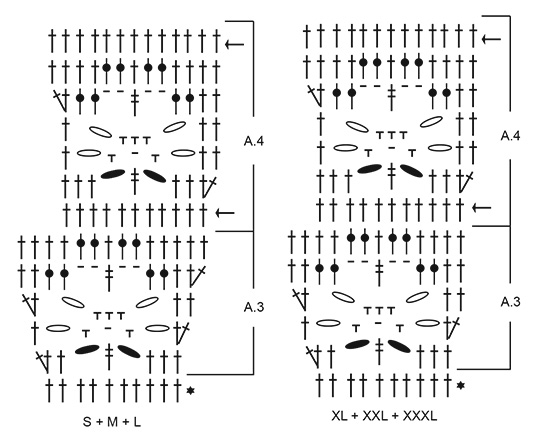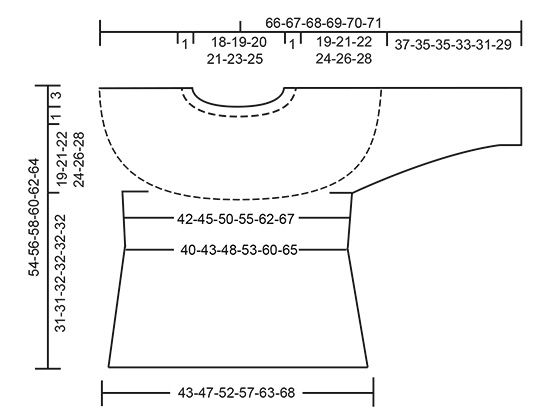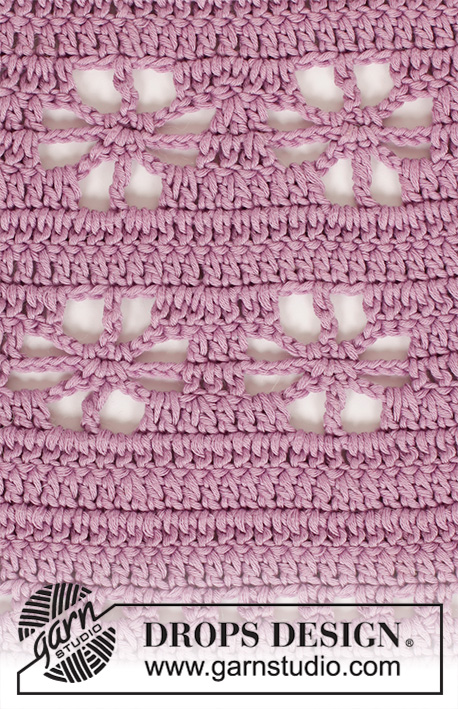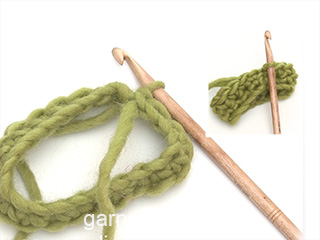Daisy Chain |
||||||||||||||||||||||||||||||||||
 |
 |
|||||||||||||||||||||||||||||||||
Crocheted sweater with round yoke in DROPS Muskat. Piece is crocheted top down with lace pattern. Size: S - XXXL
DROPS 201-5 |
||||||||||||||||||||||||||||||||||
|
---------------------------------------------------------- EXPLANATION FOR THE PATTERN: ---------------------------------------------------------- CROCHET INFORMATION: Work every row back and forth and work together at the end/beginning of every row as follows: Beginning every row with double crochets with 3 chain stitches (= first double crochet) and finish with 1 slip stitch in 3rd chain stitch at beginning of row, turn piece. Begin every row with single crochets with 1 chain stitch (does not replace first single crochet) and finish with 1 slip stitch in first single crochet, turn piece. INCREASE/DECREASE TIP: To calculate how to increase/decrease evenly, use the total number of stitches (e.g. 93 stitches) and divide stitches by number of increases/decreases to be done (e.g. 7) = 13.3. I.e. in this example increase by working 2 single crochets in same stitch in approx. every 13th stitch. To decrease evenly in this example work every 12th and 13th stitch together, i.e. work 2 double crochets together as follows: * Make 1 yarn over, insert hook in next stitch, get yarn, make 1 yarn over and pull yarn through the 2 first loops on hook *, repeat from *-* 1 more time, make 1 yarn over and pull yarn through all 3 loops on hook (= 1 double crochet decreased). PATTERN: See diagrams A.1 to A.5. Choose diagram for your size (applies to A.3 and A.4). ---------------------------------------------------------- START THE PIECE HERE: ---------------------------------------------------------- SWEATER - SHORT OVERVIEW OF THE PIECE: Work yoke and body back and forth (i.e. alternately from right and wrong side) and work together at the end of every row, top down. Work sleeves back and forth but work piece together at the end of every row, top down. YOKE: Work 109-114-118-123-129-133 chain stitches on hook size 4 mm = US 6 with Muskat and form a ring with 1 slip stitch in first chain stitch. Work 1 chain stitch - read CROCHET INFORMATION, work 1 single crochet in each of the next 3-1-5-3-2-6 chain stitches, * skip 1 chain stitch, 1 single crochet in each of the next 6 chain stitches *, work from *-* = 93-97-101-105-110-114 single crochets. Work first row from wrong side as follows: Work 1 single crochet in each single crochet and increase 7-15-23-23-30-30 stitches evenly – read INCREASE/DECREASE TIP = 100-112-124-128-140-144 single crochets. REMEMBER THE CROCHET GAUGE! Work next row as follows from right side: Work A.1 over 16-20-24-24-24-24 stitches (= 4-5-6-6-6-6 repetitions of 4 stitches) (= half back piece), work A.2 over 2-2-2-3-3-4 stitches (= 2-2-2-3-3-4 repetitions of 1 stitch), A.1 over 12 stitches (= 3 repetitions), A.2 over 2-2-2-3-3-4 stitches (= 2-2-2-3-3-4 repetitions) (= sleeve), A.1 over 36-40-44-44-56-56 stitches (= 9-10-11-11-14-14 repetitions) (= front piece), A.2 over 2-2-2-3-3-4 stitches (= 2-2-2-3-3-4 repetitions), A.1 over 12 stitches (= 3 repetitions), A.2 over 2-2-2-3-3-4 stitches (= 2-2-2-3-3-4 repetitions) (= sleeve), A.1 over 16-20-24-24-24-24 stitches (= 4-5-6-6-6-6 repetitions = half back piece). Continue to work until A.1 and A.2 have been worked vertically (= 140-152-164-188-200-224 stitches) – AT THE SAME TIME on row marked with arrow adjust number of stitches by increasing/decreasing to 140-150-160-190-200-220 stitches. Piece measures approx. 6 cm = 2⅜". Work next row as follows from right side: Work A.3 over all stitches (= 14-15-16-19-20-22 repetitions over 10 stitches). Continue to work until A.3 has been worked vertically = 196-210-224-247-260-286 stitches. Piece measures approx. 11 cm = 4⅜". Work next row as follows from wrong side: Work A.4 over all stitches (= 18-19-20-22-24-26 repetitions over 11 stitches) – AT THE SAME TIME on first row adjust number of stitches by increasing/decreasing to 198-209-220-242-264-286 stitches so that repetitions fit. Continue to work until A.4 has been worked vertically (= 234-247-260-286-312-338 stitches), but on last row increase 0-11-19-8-6-10 stitches evenly = 234-258-279-294-318-348 stitches. Piece measures approx. 19 cm = 7½". SIZE S: If measurements are not correct, work A.5 over all stitches (= 78 repetitions of 3 stitches) until piece measures 19 cm = 7½" – adjust so that next row is only with double crochets. SIZE M-L-XL-XXL-XXXL: Then work A.5 over all stitches (= 86-93-98-106-116 repetitions of 3 stitches) until piece measures 21-22-24-26-28 cm = 8¼"-8¾"-9½"-10¼"-11" – AT THE SAME TIME on 1st-2nd-2nd-4th-4th row increase 6-15-6-6-6 stitches evenly = 264-294-300-324-354 stitches. Continue until piece measures 21-22-24-26-28 cm = 8¼"-8¾"-9½"-10¼"-11", adjust so that next row is a row with only double crochets. ALL SIZES: = 234-264-294-300-324-354 stitches. Now divide body and sleeves as follows (repeat A.5 vertically until finished measurements): Work as before over the first 35-38-42-44-50-54 stitches (= half back piece), skip the next 48-57-63-63-63-69 stitches (= sleeve), work 6-6-6-12-12-12 chain stitches (= mid under sleeve), work as before over the next 68-74-84-86-98-108 stitches (= front piece), skip the next 48-57-63-63-63-69 stitches (= sleeve), work 6-6-6-12-12-12 chain stitches (= mid under sleeve) and work as before over the remaining 35-38-42-44-50-54 stitches (= half back piece). Finish body and sleeves separately. NOW MEASURE THE PIECE FROM HERE! BODY: = 150-162-180-198-222-240 stitches. Continue pattern as before over all stitches (= 50-54-60-66-74-80 repetitions A.5 of 3 stitches). When piece measures 4 cm = 1½" from division, decrease 3 double crochets evenly on next row (adjust to decrease on a row with only double crochets). Decrease like this every 4 cm = 1½" 2 times in total = 144-156-174-192-216-234 stitches. For every decrease work 1 repetition less of A.5 in width. When piece measures 14 cm = 5½" from division, increase 3 double crochets evenly (adjust to increase on a row with only double crochets). Increase like this every 4 cm = 1½" 4 times in total = 156-168-186-204-228-246 stitches. For every increase work 1 repetition more of A.5 in width. Continue until piece measures 31-31-32-32-32-32 cm = 12¼"-12¼"-12½"-12½"-12½"-12½" from division (50-52-54-56-58-60 cm = 19¾"-20½"-21¼"-22"-22¾"-23⅝" from neck in the middle of front piece), finish after 1 row with double crochets. Cut and fasten the yarn. SLEEVE: Work piece back and forth (i.e. alternately from right and wrong side) and work together with 1 slip stitch on every row. Begin by working in the 4th-4th-4th-7th-7th-7th chain stitch of the 6-6-6-12-12-12 chain stitches worked in armhole on body as follows: Work 1 slip stitch, 3 chain stitches (= 1 double crochet), 1 double crochet in each of the next 2-2-2-6-6-6 chain stitches, A.5 over the next 48-57-63-63-63-69 double crochets (= 16-19-21-21-21-23 times in width) and finish with 1 double crochet in each of the last 3-3-3-6-6-6 chain stitches under sleeve = 54-63-69-75-75-81 stitches. Insert 1 marker thread at the beginning of row. Continue pattern as before over all stitches (= 18-21-23-25-25-27 repetitions of 3 stitches). When piece measures 3 cm = 1⅛" from division, decrease 3 double crochets evenly on next row (adjust to decrease on a row with only double crochets). Decrease like this every 5½-3½-3-2-2-2 cm = 2⅛"-1¼"-1⅛"-¾"-¾"-¾" 5-8-9-11-10-11 times in total = 39-39-42-42-45-48 stitches. For every decrease work 1 repetition less of A.5 in width. Continue until piece measures 37-35-35-33-31-29 cm = 14½"-13¾"-13¾"-13"-12¼"-11⅜" from division (shorter measurements in the larger sizes because of longer yoke), finish after 1 row with only double crochets. Cut and fasten the yarn. Work the other sleeve the same way. NECK EDGE: Work back and forth over chain stitch row in neck as follows: ROW 1 (= from right side): Begin mid back, fasten yarn to piece with 1 slip stitch in a double crochet, work 2 chain stitches (= 1 half double crochet), work 1 half double crochet in every single crochet the entire row = 93-97-101-105-110-114 half double crochets. ROW 2 (= from wrong side): Work 1 single crochet in every half double crochet = 93-97-101-105-110-114 single crochets. Cut and fasten the yarn. |
||||||||||||||||||||||||||||||||||
Diagram explanations |
||||||||||||||||||||||||||||||||||
|
||||||||||||||||||||||||||||||||||

|
||||||||||||||||||||||||||||||||||

|
||||||||||||||||||||||||||||||||||

|
||||||||||||||||||||||||||||||||||
|
Have you made this or any other of our designs? Tag your pictures in social media with #dropsdesign so we can see them! Do you need help with this pattern?You'll find tutorial videos, a Comments/Questions area and more by visiting the pattern on garnstudio.com. © 1982-2024 DROPS Design A/S. We reserve all rights. This document, including all its sub-sections, has copyrights. Read more about what you can do with our patterns at the bottom of each pattern on our site. |
||||||||||||||||||||||||||||||||||
























































Comments / Questions (48)
Mine is quite twisted at the moment starting the yoke pattern. Stitches aren't but the work in general is twisted. Is this meant to happen? If not how do I fix it?
03.03.2021 - 04:12DROPS Design answered:
Dear Simone, it's a bit difficult to vizualize why your work looks like this, it might be a good idea to bring your work to your store or send them a picture by mail, they might be able to help you seeing your piece You can also join our DROPS Workshop and ask other crocheters showing your picture there. Happy crocheting!
03.03.2021 - 07:14Hallo, het gaat om het patroon Daisy chain. Daar staat bij A5, dat je in de 1e, 2e, 2e, 4e,4e rij moet meerderen ( bij de uitleg voor de pas, onderaan bij maat L XL enz). Ik snap niet wat ik moet doen.
15.02.2021 - 14:19DROPS Design answered:
Dag Eva,
Op welke toer je moet meerderen staat per maat aangegeven in de reeks getallen. Dus als je maat M haakt, meerder je op de eerste toer 6 steken verdeeld, als je maat L haakt, meerder je op de 2e toer 15 steken verdeeld, enz. Hoe je precies verdeeld meerdert staat bovenaan aangegeven bij 'Tip voor het meerderen/minderen'.
09.03.2021 - 19:47Graag uw hulp bij het afmaken van mijn Sea Waves vest. Als ik de beschrijving van de PAS volg dan ontstaat er een rare hobbel op de rug, bij de overgang van zigzag patroon naar stokjes haken.
10.10.2020 - 20:57DROPS Design answered:
Dag Wilgis,
Als het goed is trekken deze bobbels wel weg als je verder haakt. Of je kunt het werk, als het klaar is oppersen. Nog even een vraagje: Zou je de volgende keer je vraag willen stellen bij het betreffende patroon? Op die manier kunnen andere haaktsters/breisters ook de antwoorden bekijken. :) Veel haakplezier!
11.10.2020 - 14:14Merci. Je viens de saisir l'astuce. Je l'essaie tout de suite.
13.08.2020 - 14:53Dans le diagramme A.1 au rang 2, doit-on faire 2 brides dans chacune des mailles ou bien sauter 1 ou 2 mailles après les 2 mailles dans la même maille. Merci à l'avance
12.08.2020 - 19:04DROPS Design answered:
Bonjour Loulou, le nombre de mailles de A.1 ne changera jamais, on doit toujours avoir 4 mailles dans chaque A.1, pensez-vous plutôt à A.2? au 1er rang de A.2 vous crochetez 2 brides dans 1 maille, au 2ème rang, vous crochetez: 1 bride dans la bride, 1 maille en l'air, 1 bride dans la bride, 1 maille en l'air (= 4 mailles). Bon crochet!
13.08.2020 - 09:28Can you please advise how to increase on the last row of A1 and A2 to reach the 140 stitches, the increase in the diagram is just showing in A2 Thanks
16.06.2020 - 17:52DROPS Design answered:
Dear Mrs Totah, the increases will be worked in each A.2 (= you increase 5 sts in each A.2 and work 8 repeats (in size S) of A.2 in the round = 40 sts increased = there are 140 sts. this lesson shows how to read diagrams, this could help you to work A.1 and A.2. Happy crocheting!
17.06.2020 - 07:41Do the numbers in the final diagram represent number of stitches or centimeters?
07.06.2020 - 21:09DROPS Design answered:
Dear Maggie, the numbers in the final diagram represent cm. Happy crocheting!
07.06.2020 - 21:33Per favore quandi si dice lavorare a1 rip. 4 maglie si ripete solo il primo rigo oppure tutti e 4 di a1. Come faccio a sapere quando si legge solo 1 rigo da ripetere oppure tutto il diag. A1. Grazie
10.05.2020 - 18:12DROPS Design answered:
Buongiorno Annie. Si lavora una riga alla volta. Alla prima riga, lavora come indicato nella prima riga di A1 sul numero di maglie indicato. P.es per la taglia S lavora la prima riga su 16 m. Finita la prima riga, passa a lavorare come indicato nella seconda riga di A1 e così via. Il diagramma A1 viene lavorato 1 volta in verticale. Buon lavoro!
10.05.2020 - 21:11Molte mie amiche hanno rinunciato ai vs modelli perche non si capiscono bene, io testarda ci ho provato per molto tempo pensando di riuscirci, ma onestamente ho fallito anche io. Per favore potreste fare gli schemi come fanno tutti.? È un peccato ..dopo aver comprato il filo dover rinunciare e scegliere altro. Grazie
08.05.2020 - 15:51Todo está de maravilla hermosos pero la verdad nos falta el diagrama gracias
18.04.2020 - 10:12